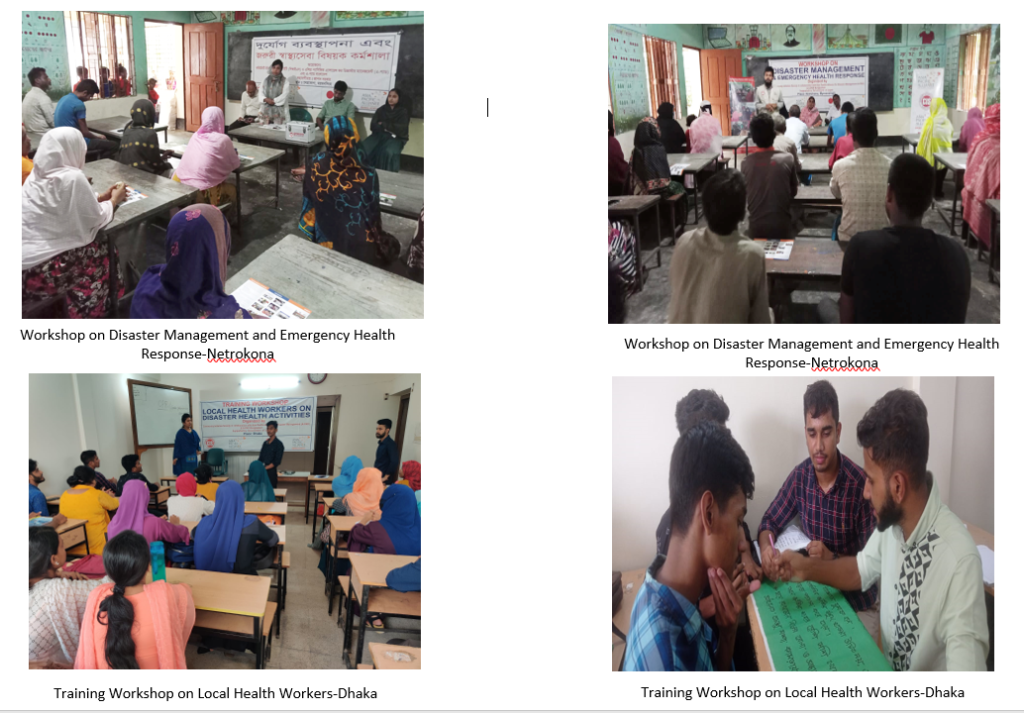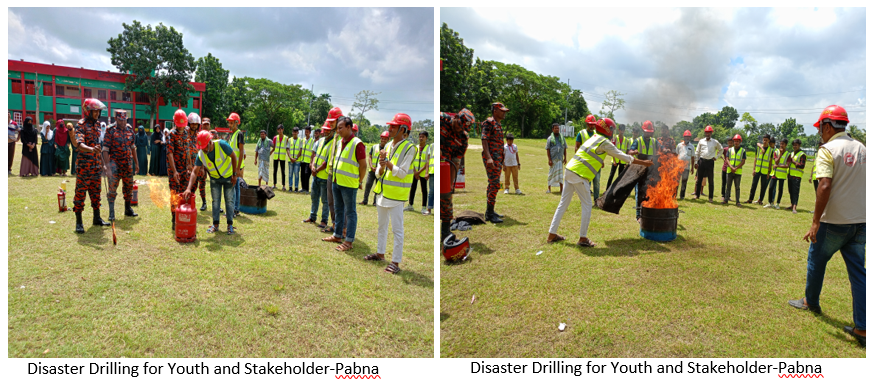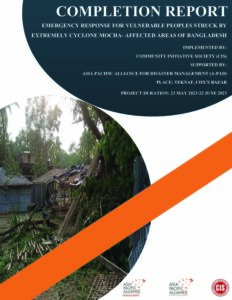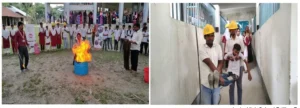A-PAD Bangladesh Activity Report
Month of July 2023
Project Title: Strengthening Capacity for Sustainable Disaster Management Network by involving multi-sectoral platform
Project Period: 17 January, 2023 – 16 January, 2024 (12 month)
- Project Activities and Accomplishments
Bangladesh is one of the most vulnerable countries to natural disasters and, due to climate change; we are facing natural disasters almost every year. Combined with the country’s geographical location, topography, and dense population, disaster events often result in high loss of life and economic loss, though Bangladesh has been successfully reducing the loss of human lives over the years. The frequency and intensity of natural disasters have increased in recent years due to climate change. The climatic events have serious consequences on broad agricultural sectors, food security, water, health, and sanitation and leave serious impacts on the life and livelihood of the communities. But so far we have limited disaster risk-related data to understand the depth of household and population characteristics and loss sustained by the community at the household levels.
A-PAD Bangladesh started the project in January 2023 and presently continues it on 17 January 2023 to build up capacity for disaster management. It communicates with the different sectors like the local community, community leaders, stakeholders, and GOVT. officials continuing training on disaster management. To hold a training program A-PAD Bangladesh staff organized small community meetings to share ideas on disasters and introduced them about A-PAD Bangladesh activity. A-PAD Bangladesh working 8 divisional areas.
There are 1 health workers in each divisions whose are doing home visit and aware the local community about basic disaster awareness. The health workers gave basic ideas about disaster management. A-PAD Bangladesh working at the rural areas. If there would be any directions or announcement from GOVT. or any disaster related news has been published the health workers delivered the message to the local community. Total 5,050 persons were benefited from A-PAD Bangladesh on July 2023.
A-PAD Bangladesh attended coordination meeting at the 8 divisions in Office of Deputy Commissioner. At that meeting different NGOs had joined and explained their activities. Besides this what will be the next activities of the GOVT. and NGOs were discussed at that meeting.
1. To manage the emergency disaster management coordination centers in disaster-prone areas (Outcome 1) The disaster management coordination center in disaster-vulnerable areas established in this project (3 year project) functions as a disaster response base in each region, and contributes for preventing the spread of health damage to local residents and community-led disaster risk reduction measures. | ||
Activities | Outcome Indicators to Measure Results: | Project Status: Achievements vs Outcome: If the activity is behind schedule, please write the reason. |
1-1 Operation of Emergency Disaster Management Coordination Centers Beneficiaries: 10 people x 25 days x 8 divisions x 12 months = 24,000 people 50 people x 8 campaign x 12 months = 4,800 people | 【Indicators of Outcome】 1-1: The disaster response management centers in 8 places (Dhaka, Chattagram, Rajshahi, Khulna, Barisal, Sylhet, Rangpur and Mymensingh division) will be utilized and the necessary equipment for emergency health care will be prepared. We will establish a new emergency disaster management coordination center in Mymensingh division. The center will function as a resource center for sharing information on disasters and will be used as a venue for strategic planning meetings, training and workshops. The staff members including doctors and nurses visit the villages and carry out awareness activities related to emergency health measures, public health and disaster prevention for local residents, and ensure that each local resident takes appropriate preventive measures.
(Indicator: number of visitors, record of services provided)
1-2: The PCR test lab installed in the previous project will continue to operate. In the first year of the project, testing will be conducted only for COVID-19. From the second year onwards, it will be expanded to other infectious diseases (tuberculosis, measles, hepatitis) according to the needs of local residents. (Indicator: number of tests, report of test results)
| Total of 3,080 people visited the Disaster Management Coordination Center to discuss disaster preparedness and health-related issues. Dhaka: 380 Persons Cox’s Bazar: 300 Persons Pabna: 420 Persons Bagerhat: 405 Persons Patuakhali: 410 Persons Habiganj: 390 Persons Rangpur: 375 Persons Netrokona: 400 Persons Total = 3,080 Persons |
1-2 Disaster Management Awareness program Beneficiaries:15 participants x 3 sessions x 8 divisions x 12 months = 4,320 people | A-PAD Bangladesh conducted Disaster Management Awareness programs at the 8 divisional areas where 379 persons participated. Total 3 times training was organized at each divisional area. Dhaka:15 Participants x 3 Sessions= 45+3=48 Participants Cox’s Bazar: 15 Participants x 3 Sessions=45 Participants Pabna: 15 Participants x 3 Sessions= 45+2= 47 Participants Bagerhat: 15 Participants x 5 Sessions= 45+5=50 Participants Patuakhali: 15 Participants x 3 Sessions= 45+2=47 Participants Habiganj: 15 Participants x 3 Sessions= 45+3= 48 Participants Rangpur: 15 Participants x 3 Sessions= 45+3=48 Participants Netrokona: 15 Participants x 3 Sessions= 45+1=46 Participants | |
1-3 Operation of PCR lab Beneficiaries: 15 people x 25 days x 12 months = 4500 people(Monthly Goal: 15 persons x 25 days = 375 persons) |
A-PAD Bangladesh established PCR Lab for COVID-19 test. In Bangladesh number of COVID-19 patients has average in number. In July 2023 total 720 COVID-19 test has been done | |
2 Strengthening the disaster response platform network (Outcome 2) A-PAD BGD, NPF for disaster reduction and disaster response through collaboration between multi-sectors, will be established and expanded, and the disaster prevention and disaster capacity of its member organizations will be strengthened. | ||
2-1 Network partner meeting Participants : 100 people x 5 villages x 8 divisions = 4000 people | 【Indicators of Outcome】 2-1 Strategies, mechanism and action plan meeting among networking partners and local communities will be held to support the building of disaster cooperation framework.
2-2 For the aim of awareness and increase the knowledge on disaster preparedness and management among the local community, we will organize different rally and meeting on the disaster preparedness and SDGs related national/international days like 05 November World Tsunami Awareness Day, 13 October Disaster Risk Reduction Day, 22 April Earth Day and 16 December Victory Day (National).
2-3 For the aim of strengthening of partner organizations, disaster risk reduction (DRR) training will be held. The training contents includes community-based disaster risk management, planning DRR strategies, and risk analysis that effectively identifies hazards, capacities and vulnerabilities. (Indicator: Partner organizations)
2-4 In this seminar, participants from various fields will be invited to exchange opinions and discuss ways to discover innovations related to DRR proposed by community residents and local companies and realize ideas and inventions. (Indicator: To create innovative solutions, we aim to create a successful model for disaster response by combining technology and knowledge that transcends fields and innovating)
2-5 The international symposium will be held in Dhaka to widely share the cooperation between multi-actors at the central and regional levels in Bangladesh and the progress of the emergency health response system among participants who are involved in disaster response from inside and outside Bangladesh. International experts will be dispatched from A-PAD member countries to introduce advanced cases of NPF in each country. (Indicator: The international symposium will be held for a total of three days, one day for field trips (field visits), one day for pre-meetings, and one day for international symposiums.)
| Disasters like cyclones, flooding, and flash floods are becoming more frequent. Despite being a disaster-prone area, the people lack preparedness and awareness to deal with these disasters. In this relation, a Network Partners Meeting has been held at five different places. A-PAD Bangladesh conducted Networking Partners Meeting at Patuakhali where total 521 Participants joined.
22 July 2023, Krishnapur, Patuakhali, Total Participants 100+5=105 Participants 23 July 2023, Moddho Dakua, Patuakhali, Total Participants 100+6=106 Participants 24 July 2023, Atkhali, Patuakhali, Total Participants 100+4=104 Participants 25 July 2023, Sutabaria, Patuakhali, Total Participants 100+3=103 Participants 26 July 2023, Krishnapur, Patuakhali, Total Participants 100+3=103 Participants The number of disaster shelters is still well below what is needed. Patuakhali district is one of the worst affected upazila by a cyclone and storm surges and many other climatic hazards. There are many cyclone shelters have been constructed in this region. These cyclone shelters provide shelter to the coastal community and help a lot to reduce the number of casualties in the coastal areas during cyclones. Normally people in the surrounding area took shelter in the cyclone shelters. As a part of preparedness for disasters, people should be evacuated to shelters/safe locations as early as possible. If people know where they should go during a disaster, they could move faster to the shelters which can reduce the mortality rate. He also added that the shelter building is quite an expensive structure, it would not be economically justifiable unless some normal time use can be ensured. The complex and active coastal zone needs to manage and requires an integrated holistic approach. this vast coastal area needs management and a holistic framework for sustainable development, conservation of coastal ecosystems and safety of coastal communities. The coastal management and development programs of the country took place in the early 1960s through undertaking several initiatives such as the construction of coastal embankments, building coastal greenbelt, land reclamation, community-based management and delta development. For Coastal management, we need:
Policy formulation: Creating a policy framework to establish a goal. Strategy planning: Potential impacts of existing policy action are explored where benefits are evaluated and where data is accumulated and where general strategy is created and recommendations are made for organizations to develop coastal communities. Program development: Once the strategy plan is accepted by policymakers, development of the program can commence and a details master plan for its implementation is created. Implementation: Once the master plan is approved public and private organizations in collaboration can come forward to implement. This 5-day meeting in Patuakhali made a significant impact on society as people are more aware of disasters and people are more interested to improve their living conditions by adopting different policies.
|
2-2 Disaster Preparedness Campaigns
Participants:100 people x 2 times x 8 divisions = 1,600 people |
| |
2.3 Network Partners Capacity Strengthening (DRR) Participants:30 people x 2 org x 8 divisions x 2 times =960 people
| A-PAD Bangladesh organized Networking Partners Capacity Strengthening DRR at Cox’s Bazar where 62 Participants joined at the training programs. 15-16 July 2023, Cox’s Bazar, Total Participants 65 Cox’s Bazar is one of the districts of Bangladesh already vulnerable to many gradual changes. Many Disasters happen every Year in Cox’s Bazar. Especially Cyclones and landslides are one of them. To prevent the loss of Cyclone and landslide CIS work beside the government sector in Cox’s Bazar. CIS Cox’s Bazar conducted Network Partners Capacity Strengthening (DRR) at Cox’s Bazar Sadar. In this 2 days training program, 2 organizations come forward in the time of emergencies. Disaster On the 1st Day, the Program Manager of Integrated Social Development Effort (ISDE), Jashim Uddin discussed Effective disaster mitigation measures. He also discussed the coastal management strategy that needs to take. The Coastal Development Strategy is a national policy with a multi-sectoral approach. The objectives of the Strategy are (i) Safe and fresh water supply, (ii) Disaster risk reduction, (iii) Efficient coastal zone management, (iv) Economic growth, (v) Sustainable management of natural resources, (vi) Improved livelihoods, (vii) Environmental protection, (viii) Public awareness-raising, and (ix) Institutional capacity building.
To introduce disaster management and disaster Risk of disaster-prone areas of Cox’s Bazar. After the training, participants were familiarized with disaster Management terminologies and concepts. In addition, this section also covers the history and disaster risk profile of different contexts and linkages of disasters to development. The Basic concept of Disaster Management including the impact of disasters, vulnerabilities, prevention, mitigation and the various disaster classifications were covered. The future aim of the training is to coordinate the work of actors at the local level, private organizations and the stakeholders.
| |
2-4 Seminar for Developing New Disaster Prevention Solutions Participants:40persons x 8 divisions x 2times =640 participants | Total 2 days seminar has been organized at Habiganj where 42 persons joined. 19-20 July 2023, Habiganj, Total Participants 42 The main objective of the Seminar for Developing New Disaster Prevention Solutions is to promote knowledge exchange and collaboration among experts, practitioners, and policymakers in the field of disaster prevention and management. The seminar aims to provide a platform for participants to share their knowledge, research findings, best practices, and innovative solutions to prevent and mitigate the impact of disasters on society The Seminar for Developing New Disaster Prevention Solutions is aimed at bringing together a diverse range of participants from different sectors and backgrounds. The following are examples of potential participants.
| |
2-5 International Symposium on DRR
Participants:200 persons |
| |
3. Strengthening disaster resilience of local communities
(Outcome 3) 3-1 Disaster response capacity building of local community level in Health and hygiene field | ||
3-1 a) ) Workshop on Disaster Management and Emergency Health Response
Participants:40 persons x 8 divisions x 2 times = 640 persons
| 【Indicator of Outcome】 3-1 a) Workshops will be held to understand emergency disaster preparedness, health response and hygiene needs in communities, schools and homes and to learn how to respond during emergencies. Networks of stakeholders will be built through the workshop.
(Indicator: Local citizens, Community leaders, Local NGO, Private sector workers)
b) Workshop for healthworkersfrom local organizationswillbeheld to understand emergency health and hygieneneeds and learn how to respond to emergencies. The healthworkerswhofinishedthis trainings are supposed to becomemember of disastervolunteerrescue team in the activity. | Community Initiative Society (CIS) organized Workshop on Disaster Management and Emergency Health Response in Netrokona on July 2023. The Workshop on Disaster Management and Emergency Health Response organized by the Community Initiative Society provided a valuable platform for professionals to enhance their knowledge and skills in disaster management and emergency health response. 09-10 July 2023, Netrokona, Total Participants 40+4=44 Participants The Workshop on Disaster Management and Emergency Health Response aimed to achieve the following objectives: a) Focus on preparedness: Emphasizing the importance of preparedness in effectively managing and responding to disasters. Preparedness measures include risk assessment, early warning systems, emergency planning, and resource allocation. b) Enhance resilience: Building the capacity of individuals, communities, and organizations to bounce back and recover quickly from disasters. Resilience involves strengthening infrastructure, promoting adaptive practices, and fostering social cohesion. c) Improve understanding: Enhancing participants’ understanding of disaster management principles, strategies, and frameworks. This includes comprehensive knowledge of emergency health response, medical care, psychosocial support, and coordination mechanisms. d) Knowledge exchange: Creating a platform for participants to share experiences, challenges, and best practices in disaster management and emergency health response. This fosters collaboration and encourages the adoption of effective strategies in different contexts. |
3-1 b) Training of Local Health Workers on Disaster Health Activities
Participants:25 pers/time x 8 divisions = 200 persons | Total 3 days training organized at Dhaka with the participants of local health workers. 04-06 July 2023, Dhaka, Total Participants 25 Local health workers help ensure equity in health at grassroots levels – urban and remote – and contribute to country efforts to ensure health care for all, particularly the poor, underserved and underprivileged. These workers are trained in hygiene, first aid, immunization and other essential primary health care services and form the backbone of any emergency health response. Mobilizing grassroots health action by people is a basic function of community health workers. This way, they empower people and different sectors to protect public health by detecting disease outbreaks, preventing malnutrition, promoting healthy behavior and avoiding hazards In the training workshop it was discussed about the roles and their work has been repeatedly linked to health outcome improvement, an additional discipline where Community Health Workers may provide valuable support is disaster response. When a community is faced with disaster, they may be able to step in and offer emergency aid in two main areas to include: 1. Providing emotional and social support2. Assessing resource availability and medical needs3. Helping beneficiaries access essential resources4. Educating communities about health issues and how to access care | |
3-2 Strengthening disaster response capacities of local communities through disaster drilling training | ||
3-2 a) Women Empowerment and Capacity Building Participants:20 persons X 8 Divisions X 2 Session = 320 participants
| 3-2 a)Building women empower and capacity building through improving their knowledge and skills on disaster risk reduction, in order to involve them in disaster planning and policy making. A women’s group will be trained in the field of maternal and child health, hygiene and environment sanitation, nutrition. (Indicator: A women’s group will be trained in the field of maternal and child health, hygiene and environment sanitation, nutrition.)
b) Drilling training session will be conduct to the local stakeholders, youth group and homes and to learn how to respond the fire, flood, cyclone, landslide and earthquake disasters and rescue at the emergencies. To conduct this training session, we will prepare a training manual and a curriculum collaboration with the department of fire service and civil defense of GoB. (Indicator: After the practical training session two disaster volunteer rescue team will be established in each divisional area.)
c) Drilling training session for the public junior high school students and teachers will conduct at the school based focusing self-protection during and after disaster. Manual will be designed for the school children in cooperation with the department of fire service and civil defense of GoB (Indicator: Participated schools will be supported to develop their emergency management plans.)
In order to widely share and disseminate the activities of this project and the experiences and lessons learned through the activities, situation reports and activity reports in the event of a disaster will be published on the A-PAD BGD website. | Rangpur district is one of the disaster-prone areas in Bangladesh. Women are often particularly vulnerable to the effects of disasters, as they may have limited access to resources and support networks that can help them cope with the aftermath. 30-31 July 2023, Rangpur, Total Participants 20+6=26 Participants Including women in recovery helps reduce stereotypes and discrimination about women’s roles. By promoting disaster awareness and preparedness among women in Rangpur, CIS is helping to build resilience and reduce the impact of disasters on vulnerable communities. This program is an important component of CIS’s broader efforts to promote women empowerment and capacity building training, and reflects a commitment to creating a more equitable and sustainable society in Rangpur. Community Initiative Society (CIS) organized a two-day event with a primary focus on women empowerment and capacity building. The event aimed to enhance the skills and capabilities of women, enabling them to assume leadership roles and actively participate in decision-making processes. To achieve this, a series of drilling activities were organized to facilitate experiential learning and skill development among the participants. The program’s target participants are women in the Rangpur community, particularly those who are vulnerable to disasters due to their social and economic status. These may include women from low-income households, single mothers, widows, and women with disabilities. The event included various activities such as workshops, interactive sessions, group discussions, role-playing exercises, and practical demonstrations. Workshops were conducted by experienced trainers and professionals specializing in areas relevant to women’s empowerment. These workshops covered topics like leadership development, communication skills, entrepreneurship, financial literacy, and self-confidence building. Participants received practical knowledge, guidance, and support to overcome barriers and challenges. |
3-2 b) Disaster Drilling for the Youth and Local Stakeholders Participants:45 persons x 8 divisions x 2 times = 720 persons
| A-PAD Bangladesh conducted drilling programs for the youth and the local stakeholder in Bagerhat. Total 2 days of drilling session was organized and 50 participants joined.
11-12 July 2023, Netrokona, Total Participants 45+5=50 Participants 19-20 July 2023, Bagerhat, Total Participants 45+5=50 Participants 25-27 July 2023, Pabna, Total Participants 45+3=48 Participants
Clearly defines roles and responsibilities related to disaster reduction at the national, and municipal government levels, as well as the civil society level, including community organizations and citizens. This requires the three levels of government to draw up master disaster management plans. So that CIS prepare disaster management plans for their sectors. Cyclone: · Clearly assigned federal responsibilities · Developed comprehensive and well-organized disaster preparedness.
Earthquake: · Disaster management mechanisms through volunteer groups and private organizations; · Reduce requirements for establishing the Extreme Disaster Management Headquarters; · Certified disaster relief requests for the Self-defense Force and other relevant organizations. | |
3-2 c) Disaster Drilling for Junior High Schools Participants:45 persons x 8 divisions x 2 times = 720 persons |
| |
3-3 Update website contents as E-resources for Disaster Management | https://apad-bd.org/completion-report-cyclone-mocha-2023/ | |
- Challenges
Please write Challenges and its impact upon the project implementation. (Ex.lockdown, Political situation, Curfew)
- Practice in collaborationwithA-PAD Bangladesh Network Partners
Please write good practice in collaboration with partner organizations
- Any contributionFunds Received and Grants Applied / Planned and Implemented Projects by CIS including Emergency Response
Please write Projects name and its fund resources
- Relationship with Bangladesh Government and Japanese Embassy
Please write about Meeting with Government officials










